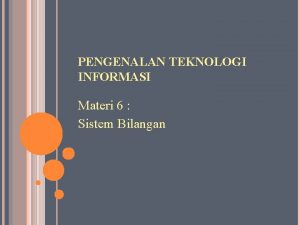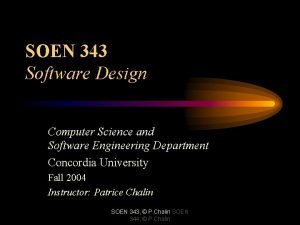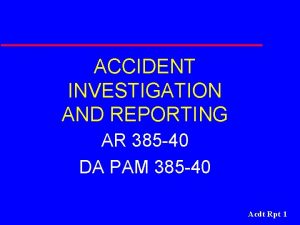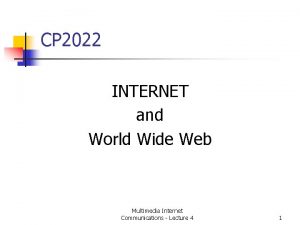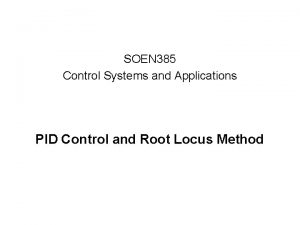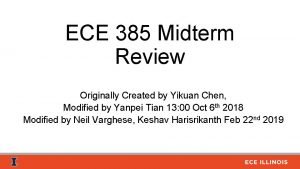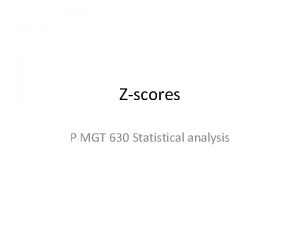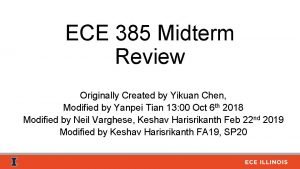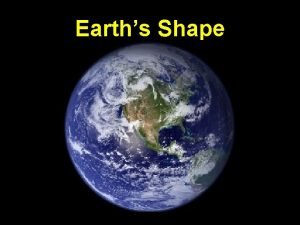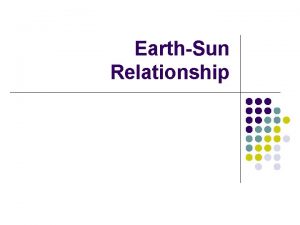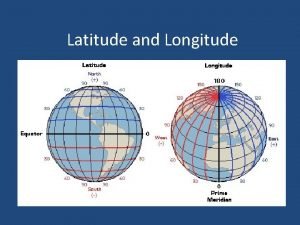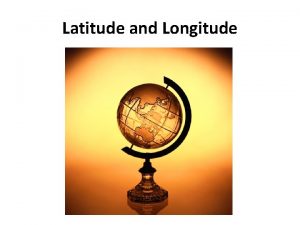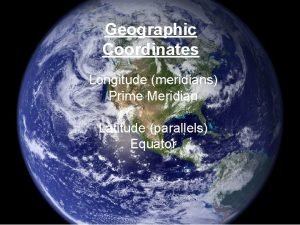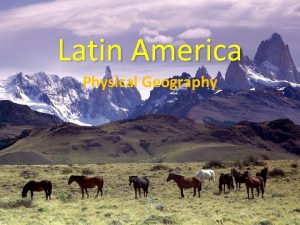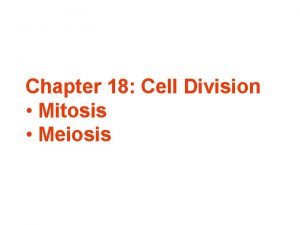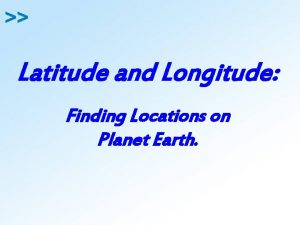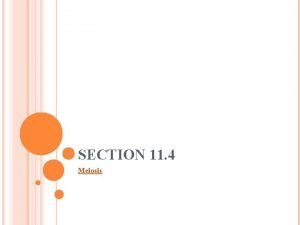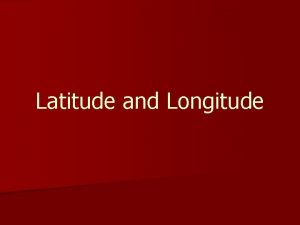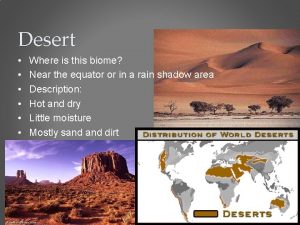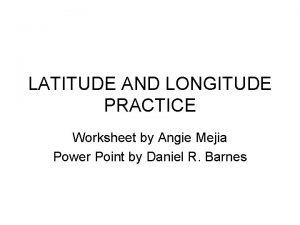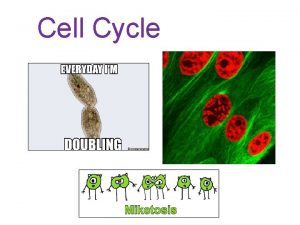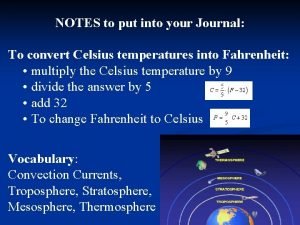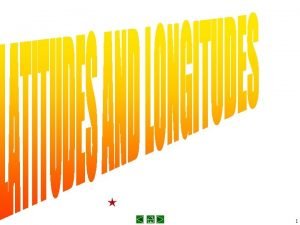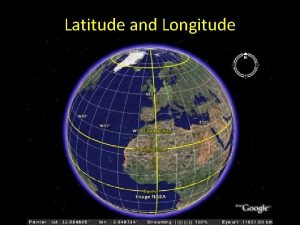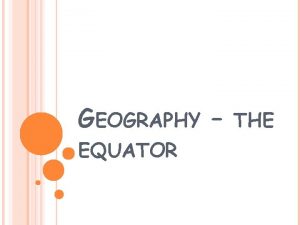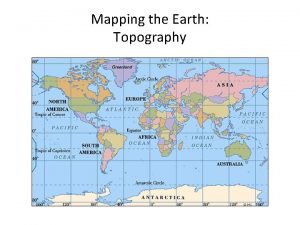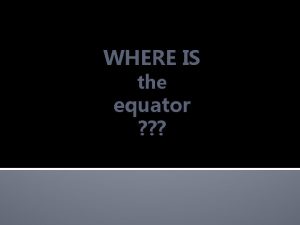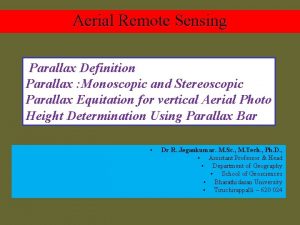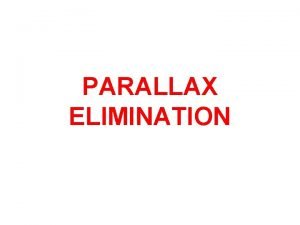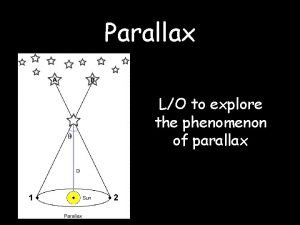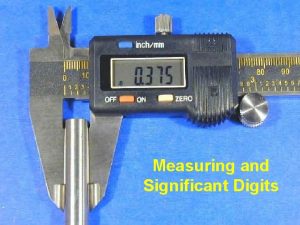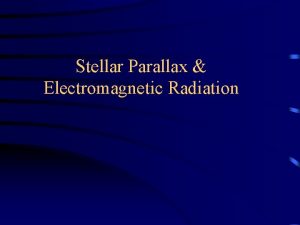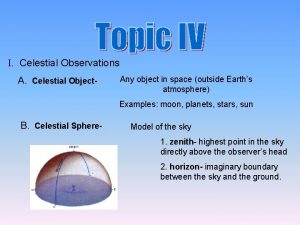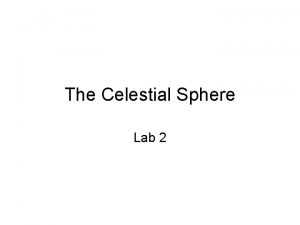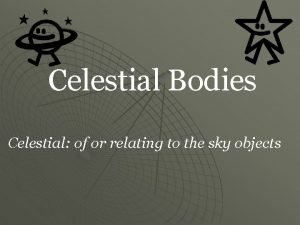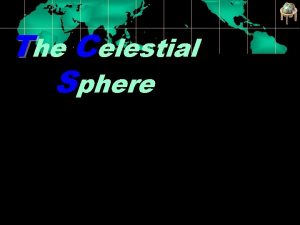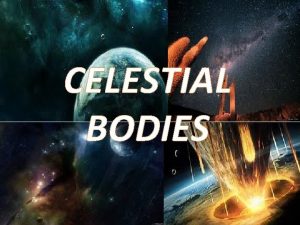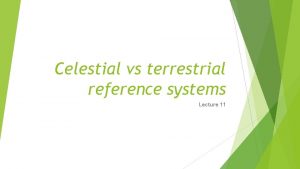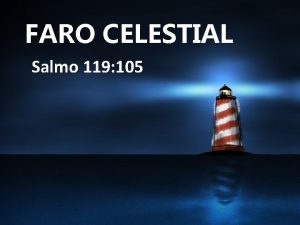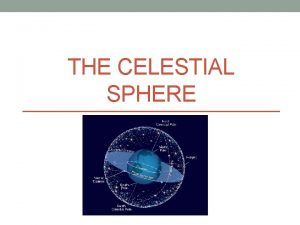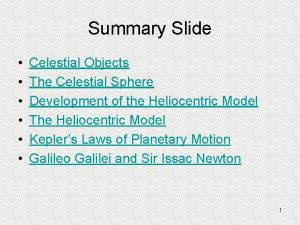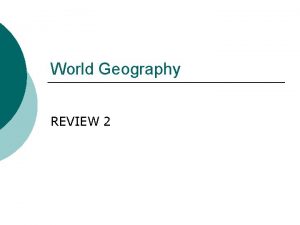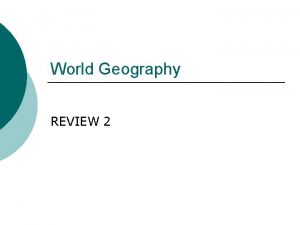385 F 16 REVIEW equant parallax celestial equator











































- Slides: 43

385 F 16 REVIEW

___ equant ___ parallax ___ celestial equator ___ solstice ___ hippopede ___ precession ___ ecliptic ___ eccentric ___ retrogression ___ deferent ___ empyreum ___ equinox ___ epicycle A. event causing earlier equinoxes in each successive year B. apparent reverse motion of planet C. point of intersection of celestial equator and ecliptic D. outermost celestial sphere E. orbit carrying an epicycle F. point opposite Earth and equidistant from center G. pattern produced by embedded spheres on offset axes H. apparent shift in position of object against background I. plane projected from Earth’s middle intersecting celestial sphere J. orbital center offset from true center K. point of greatest angular difference between Sun and ecliptic L. orbit carried on larger orbital path M. apparent path of Sun and planets

F__ equant H__ parallax I__ celestial equator K__ solstice G__ hippopede A__ precession N__ ecliptic J__ eccentric B__ retrogression E__ deferent D__ empyreum C__ equinox L__ epicycle A. event causing earlier equinoxes in each successive year B. apparent reverse motion of planet C. point of intersection of celestial equator and ecliptic D. outermost celestial sphere E. orbit carrying an epicycle F. point opposite Earth and equidistant from center G. pattern produced by embedded spheres on offset axes H. apparent shift in position of object against background I. plane projected from Earth’s middle intersecting celestial sphere J. orbital center offset from true center K. point of greatest angular difference between Sun and ecliptic L. orbit carried on larger orbital path M. apparent path of Sun and planets

Practical uses of astronomy. Objects and events accessible to naked eye astronomy. Parameters for model proposed by Plato. Aristotelian universe: 5 elements, motion, 4 causes, dynamis and energeia. Contributions of Eudoxus, Heracleides, Aristarchus, Apollonius, Hipparchus, Eratosthenes, Ptolemy. Confirmation/violation of parameters. Astronomical instruments. Shifts Classical Hellenistic Periods Outline of Stoic philosophy. Outline of Epicurean philosophy. Use of astrology in Roman Republic. Ancient arguments pro and contra astrology. Types of astrology. General form of horoscopes. Christian objections to astrology. Factors in decline of ancient science. Christian attitudes towards science.

Practical uses of astronomy. • navigation • planting and harvest cycles • civic and religious calendars • measurement of seasonal lengths

Objects and events accessible to naked eye astronomy. • Sun: risings and settings (E-W), seasonal shifts, altitudes • Moon : risings, settings (E-W), phases, seasonal shifts • 2000 -3000 stars [aplanê astra]: central band of 12 constellations (zodiac), risings and settings (E-W), seasonal shifts • Planets [planêtes] : Mercury, Venus, Mars, Jupiter, Saturn: risings and settings (E-W), seasonal shifts, retrogradations • comets • meteors • occultations • eclipses

Parameters for model proposed by Plato. Account for : • E-W movement of all celestial bodies around Earth. • annual E-W movement of zodiac along ecliptic • W-E movement of Sun, Moon, planets against background of zodiac • varying speeds of planetary motion relative to zodiac (Moon = 1 month; Saturn = 30 years) • retrogression of planets Parameters: • celestial bodies travel on spheres (not bands) • celestial motion circular and constant • movement of spheres Sun, Moon, planets independent and opposite movement of sphere of fixed stars • Sun, Venus, Mercury move at roughly same speed • earth spherical (not flat disk) • universe geocentric

Aristotelian universe: 5 elements, motion, 4 causes, dynamis and energeia. • earth, water, air, fire, aither • terrestrial linear and terminal; celestial circular and perpetual.

Aristotelian universe: 5 elements, motion, 4 causes, dynamis and energeia. • Forced displacement terrestrial movement (4 elements). • Something unmoved celestial movement (5 th element). • Source of all movement = Unmoved Mover = God. • God perfect, complete, autonomous, self-actualized (energeia). • God embodies telos of the dynamis embodied in all things: perfect self -actualization (energeia). • Desire to become God all movement.

Contributions of Eudoxus, Heracleides, Aristarchus, Apollonius, Hipparchus, Eratosthenes, Ptolemy. ___ Plato ___ Empedocles ___ Heracleides ___ Anaximander ___ Philolaos ___ Eudoxus ___ Aristarchus ___ Eratosthenes ___ Apollonius ___ Ptolemy ___ Hipparchus ___ Aristotle A. equant orbit B. four causes C. circumference of Earth D. Earth offset from orbital center E. precession of equinoxes F. four elements G. pyrocentrism H. orbits around deferents I. Spindle of Necessity J. hippopede K. heliocentrism L. ring of fire

__I_ Plato __F_ Empedocles __H_ Heracleides __L_ Anaximander __G_ Philolaos __J_ Eudoxus __K_ Aristarchus __C_ Eratosthenes __D_ Apollonius __A_ Ptolemy __E_ Hipparchus __B_ Aristotle A. equant orbit B. four causes C. circumference of Earth D. Earth offset from orbital center E. precession of equinoxes F. four elements G. pyrocentrism H. orbits around deferents I. Spindle of Necessity J. hippopede K. heliocentrism L. ring of fire

Confirmation/violation of parameters. CONFIRM • universe orderly, finite, rational • position and movement governed by place, not space • two distinct divisions of place *terrestrial/sublunary: radial motion; 4 elements; change; birth, growth, maturation, decay *celestial: circular motion; aithêr; changeless, uniform, perfect • spherical shells of aithêr; no empty space *Earth – Moon – Mercury – Venus – Sun – Mars – Jupiter – Saturn – fixed stars (empyreum) – Unmoved Mover

• Eudoxan spheres and epicyclic model (Heracleides) both consistent with premises • eccentric (Apollonius) model violates geocentric premise • equant model (Ptolemy) violates geocentric premise, perfect circular motion, uniform speed

Astronomical instruments • skaphê/gnômon • dioptra • armillary sphere • Antikythera mechanism

Shifts Classical Hellenistic Periods • loss of traditional community frameworks • inadequacy of polis religion • rise of eschatological cults (Pythagoreanism, Orphism) and associations • influx of foreign (religious, magical) influences • consolidation of power in bureaucracies and totalitarian systems • rise of interest in magic • rise of individualistic philosophies • rise of interest in astrology

Stoic philosophy Physics / Theology * Foundation in Parmenidean monism. * Universe essentially one "stuff"—material, animate, rational, divine. * Differences attributable to different degrees of “tension” (tonos). * Logos (Rationality) = God = Fate = Reason = Fire. * Universe periodically destroyed by fire (ekpyrosis), followed by emergence of identical universe. * Hard determinism prevails. new, Ethics * Free will = to will the necessary. Unhappiness = refusal to conform to inevitable. * Virtus = only good, only evil = failure to achieve it; all else indifferent. * Pain and death not evil; pleasure not a good; life itself not inherently good. * Happiness = freedom from disturbance (apathia) from outward events and inward passions. * Commitment to rationality pursuit of the common good, selfless commitment to family, city, nation, and race.

Epicurean philosophy Physics * Foundation in Demokritean corpuscular/atomic theory. *Reality is composed of invisible atoma in infinitely different sizes and shapes. *At indeterminate times and places atoma swerve and collide. *Clusters of interlocking atoma give rise to things in the world. Theology *Gods are made of fine, round atoma, and can neither be touched, nor can they touch human beings. *Death is a dispersal of atoma. Ethics *Only unconditional good = pleasure. Only unconditional evil = pain. *Pleasure mainly negative = freedom from pain and trouble (ataraxia). *Free will = corollary to "swerve" of atoma. *Avoid public life, emotional contacts.

Use of astrology in Roman Republic • astronomical/astrological hierarchies and political hierarchies • imperial endorsement widespread popularity • personal astrologers for prominent/wealthy individuals • political danger of astrological forecasts • later bans on casting imperial horoscopes

Ancient arguments pro and contra astrology. PRO • Stoic monism • sympathia • divination • seasons, tidal flow • influence on elements • humoral affects CONTRA • distance too great • skewed perspectives • different personal outcomes • lack of uniform influence • logical contradictions (catarchic astrology) • moral (ir)responsibility

Types of astrology. • General Astrology *state of universe; royal horoscopes • Kh 0 rography *astral influence on places (epidemiology, character) *astral influence on body parts • Genethlialogy *natal astrology • Catarchic Astrology *propitious moment (cf. medicine) • Interrogatory Astrology *success/failure of actions

General form of horoscopes. • dodecatemories : division into 12 zodiac houses • decans : celestial/demonic rulers of 10˚ of each house • angles * ascension : sign rising in east at moment of birth * conjunction : 0 -10˚ relation between two objets * opposition : 180˚ relation between two objects • ephemerides : tables of daily risings/settings of celestial bodies

Christian objections to astrology. • Stars as signs, not causes. • Stars as signs only for higher powers to interpret. • Magi had accurate astrological knowledge as a special, limited dispensation. • Astrology as forbidden knowledge, a temptation that appeals to human curiositas. • Baptism in Christ frees initiate from astral determinism.

Factors in decline of ancient science. • decline in scientific research • rise in commentarial tradition • shift from investigation to transmission • organization of educational system around canon • codification/exclusion of fields of scientific study • decreased funding for research • disconnect between academic and practical pursuits • failure of science to institutionalize • anxiety of influence • skeptical tradition • despair over observational, instrumental, cognitive limits • assumption of finitude of knowledge • contemplative ideal • institutionalized hostility to science from empowered Church

Christian attitudes towards science. • rejection of curiositas (~ Pride) • irrelevance of scientific (worldly) knowledge • scientific pursuits distracting and potentially corrosive • “pagan” science as false and derivative • Athens vs. Jerusalem : Science vs. Scripture • anti-intellectualism of Church • knowledge vs. belief • inference vs. revelation

DIAGRAMS




Eudoxan hippopede

Anaximander

heliocentrism (Aristagoras)

Angles

epicycle (Heracleides)

eccentric (Apollonius)

Antikythera Mechanism

pyrocentrism & Counter-Earth (Philolaos)

precession (Hipparchus)

Dodecatemories

eccentric epicycle (Apollonius)

parallax (Hipparchus)

Decans

Circumference of Earth (Eratosthenes)

Eudoxan Spheres
 Xkcd 385
Xkcd 385 Bentuk bilangan oktal dari bilangan desimal 385
Bentuk bilangan oktal dari bilangan desimal 385 Soen 343
Soen 343 385/40
385/40 Fort polk dmv
Fort polk dmv Mgt 385
Mgt 385 459-393-385
459-393-385 Soen 385
Soen 385 Parallax
Parallax Em 385 1 1 2014
Em 385 1 1 2014 Ece 385 lab 8
Ece 385 lab 8 16-385 computer vision
16-385 computer vision Zscore excel
Zscore excel Ece385
Ece385 Spherical shape
Spherical shape Hawaii equator
Hawaii equator 0 ll
0 ll Equator and prime meridian
Equator and prime meridian Longitude and latitude
Longitude and latitude Camera vitrea bulbi
Camera vitrea bulbi 23½ degrees south of the equator
23½ degrees south of the equator Latitudinal geographic zones
Latitudinal geographic zones Local weather patterns
Local weather patterns Proyeksi bonne (equal area)
Proyeksi bonne (equal area) Andes mountains map
Andes mountains map Equator in mitosis
Equator in mitosis Latitude is east to west
Latitude is east to west Prophase ii meiosis
Prophase ii meiosis Westelies
Westelies Label the lines of latitude and longitude
Label the lines of latitude and longitude Where is this
Where is this Practice latitude and longitude
Practice latitude and longitude 52
52 Spindle fibers
Spindle fibers Surface area to volume ratio
Surface area to volume ratio Which blow steadily toward the equator?
Which blow steadily toward the equator? Home sweet biome crossword
Home sweet biome crossword Weather and climate video
Weather and climate video The _____ are windless zones near the equator.
The _____ are windless zones near the equator. Which of the following is not part of overall biodiversity
Which of the following is not part of overall biodiversity Is borneo on the equator
Is borneo on the equator Latitude or distance from the equator
Latitude or distance from the equator Main latitude
Main latitude Superior temporal arcade
Superior temporal arcade

